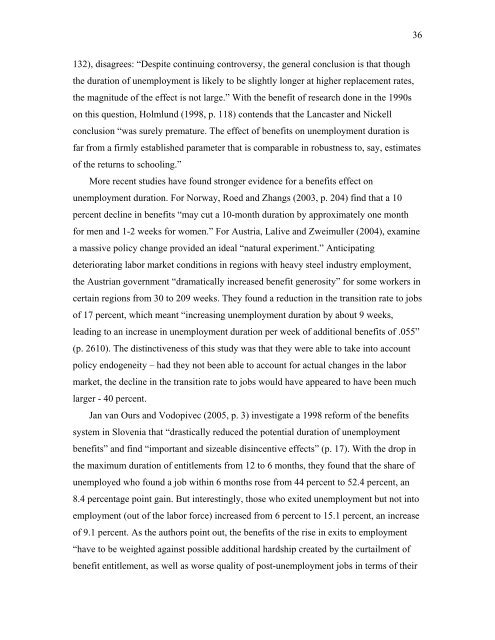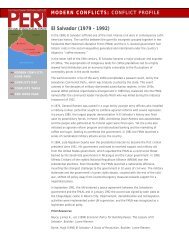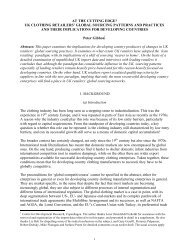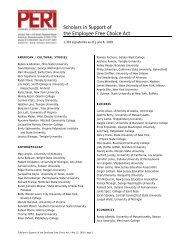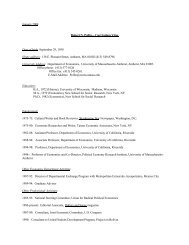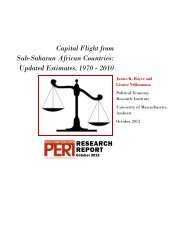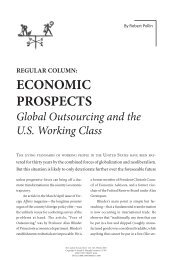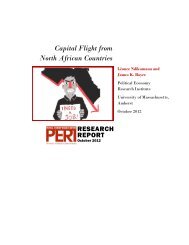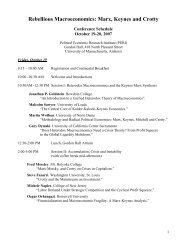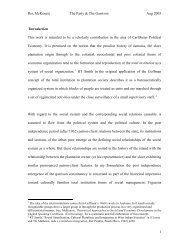Are Labor Market Institutions Really at the Root of Unemployment ...
Are Labor Market Institutions Really at the Root of Unemployment ...
Are Labor Market Institutions Really at the Root of Unemployment ...
You also want an ePaper? Increase the reach of your titles
YUMPU automatically turns print PDFs into web optimized ePapers that Google loves.
36<br />
132), disagrees: “Despite continuing controversy, <strong>the</strong> general conclusion is th<strong>at</strong> though<br />
<strong>the</strong> dur<strong>at</strong>ion <strong>of</strong> unemployment is likely to be slightly longer <strong>at</strong> higher replacement r<strong>at</strong>es,<br />
<strong>the</strong> magnitude <strong>of</strong> <strong>the</strong> effect is not large.” With <strong>the</strong> benefit <strong>of</strong> research done in <strong>the</strong> 1990s<br />
on this question, Holmlund (1998, p. 118) contends th<strong>at</strong> <strong>the</strong> Lancaster and Nickell<br />
conclusion “was surely prem<strong>at</strong>ure. The effect <strong>of</strong> benefits on unemployment dur<strong>at</strong>ion is<br />
far from a firmly established parameter th<strong>at</strong> is comparable in robustness to, say, estim<strong>at</strong>es<br />
<strong>of</strong> <strong>the</strong> returns to schooling.”<br />
More recent studies have found stronger evidence for a benefits effect on<br />
unemployment dur<strong>at</strong>ion. For Norway, Roed and Zhangs (2003, p. 204) find th<strong>at</strong> a 10<br />
percent decline in benefits “may cut a 10-month dur<strong>at</strong>ion by approxim<strong>at</strong>ely one month<br />
for men and 1-2 weeks for women.” For Austria, Lalive and Zweimuller (2004), examine<br />
a massive policy change provided an ideal “n<strong>at</strong>ural experiment.” Anticip<strong>at</strong>ing<br />
deterior<strong>at</strong>ing labor market conditions in regions with heavy steel industry employment,<br />
<strong>the</strong> Austrian government “dram<strong>at</strong>ically increased benefit generosity” for some workers in<br />
certain regions from 30 to 209 weeks. They found a reduction in <strong>the</strong> transition r<strong>at</strong>e to jobs<br />
<strong>of</strong> 17 percent, which meant “increasing unemployment dur<strong>at</strong>ion by about 9 weeks,<br />
leading to an increase in unemployment dur<strong>at</strong>ion per week <strong>of</strong> additional benefits <strong>of</strong> .055”<br />
(p. 2610). The distinctiveness <strong>of</strong> this study was th<strong>at</strong> <strong>the</strong>y were able to take into account<br />
policy endogeneity – had <strong>the</strong>y not been able to account for actual changes in <strong>the</strong> labor<br />
market, <strong>the</strong> decline in <strong>the</strong> transition r<strong>at</strong>e to jobs would have appeared to have been much<br />
larger - 40 percent.<br />
Jan van Ours and Vodopivec (2005, p. 3) investig<strong>at</strong>e a 1998 reform <strong>of</strong> <strong>the</strong> benefits<br />
system in Slovenia th<strong>at</strong> “drastically reduced <strong>the</strong> potential dur<strong>at</strong>ion <strong>of</strong> unemployment<br />
benefits” and find “important and sizeable disincentive effects” (p. 17). With <strong>the</strong> drop in<br />
<strong>the</strong> maximum dur<strong>at</strong>ion <strong>of</strong> entitlements from 12 to 6 months, <strong>the</strong>y found th<strong>at</strong> <strong>the</strong> share <strong>of</strong><br />
unemployed who found a job within 6 months rose from 44 percent to 52.4 percent, an<br />
8.4 percentage point gain. But interestingly, those who exited unemployment but not into<br />
employment (out <strong>of</strong> <strong>the</strong> labor force) increased from 6 percent to 15.1 percent, an increase<br />
<strong>of</strong> 9.1 percent. As <strong>the</strong> authors point out, <strong>the</strong> benefits <strong>of</strong> <strong>the</strong> rise in exits to employment<br />
“have to be weighted against possible additional hardship cre<strong>at</strong>ed by <strong>the</strong> curtailment <strong>of</strong><br />
benefit entitlement, as well as worse quality <strong>of</strong> post-unemployment jobs in terms <strong>of</strong> <strong>the</strong>ir


